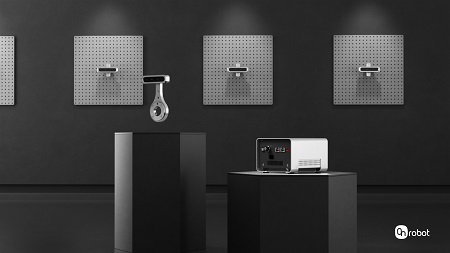
Robotic arms are often tasked with picking items not presented in the same orientation, shape or size. To provide consistent positioning, manufacturers frequently add fixtures, bowl feeders and other hardware, adding cost and complexity to what ends up being rigid applications that lack the ability to easily pick different objects or achieve quick changeover times.
“A significant part of our customer base does not want to be tied to a fixed incoming position of a product they want to pick,” says CEO of OnRobot, Enrico Krog Iversen. “They would love to eliminate complicated, bulky and expensive part feeders and fixtures to achieve this, but until now, vision systems have felt out-of-reach. Our new Eyes vision system changes all that.”
As opposed to other vision systems on the market, Eyes just needs to take a single image for calibration and part recognition, and has automatic focus to work at different distances within the same application.
Eyes is ideal for sorting a wide variety of objects or for CNC machine tending with metal parts that are defined by outer shape, as well as many other pick-and-place applications where orientation is important. Eyes also offers depth perception within its affordable and easy-to-deploy 2.5D vision.
“2.5D is rapidly emerging as the perfect technology for vision-guided applications,” says Iversen. “Compared to 2D it adds not only length and width but also height information for the specific part, which is ideal when objects may vary in height or if objects must be stacked.”
Eyes can be easily mounted on the robot wrist or externally, and integrates seamlessly with all leading collaborative and light industrial robot arms through OnRobot’s One System Solution, a unified mechanical and communications interface based on the company’s Quick Changer, now an integrated part of all OnRobot products.
The new vision system directly interfaces with other OnRobot devices making it is very easy to use Eyes together with any of OnRobot’s grippers. With a dual setup, using a dual Quick Changer, the gripper’s tool center point (TCP) can be automatically configured by Eyes, eliminating any potential conflict between different software packages from different tool vendors. The optimal mounting depends on the application. Some of the advantages of having Eyes mounted externally is not having to worry about cables running alongside the robot and the ability to optimize cycle time, as Eyes can take the picture and process this, while the robot is doing another operation.
Robotic collaborative application increasing in demand in Asia
According to the IDC Worldwide Semi-annual Robotics and Drones Spending Guide, spending on robotics and associated services will reach $129.4 billion by 2022, three times the spending in 2018, with a five-year CAGR of 25.2% during 2017-2022 in Asia Pacific excluding Japan (APEJ).
Global Market Insights reported that the global robotic end-effector market was worth more than $2.5 billion in 2018, with a projected 14% CAGR from 2019 to 2025. Key factors driving growth include increased adoption of robots to perform tasks such as machine tending, welding and others.
Also, the robotic end-of-arm tools market in APEJ has been growing exponentially as developing countries transform their industrial landscape with new technologies. In 2018, APEJ end-effector sales accounted for over 51 per cent of the global mark.
Air Jordan













